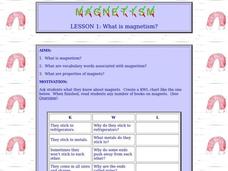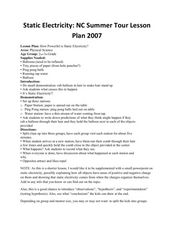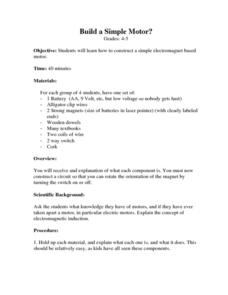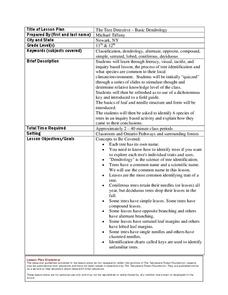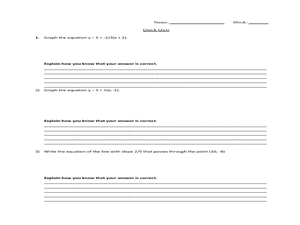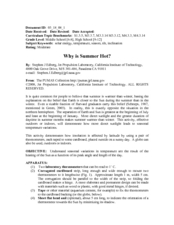National Endowment for the Humanities
James Madison: Raising an Army—Balancing the States and the Federal Government
To war! To war! Every nation in the history of the world has had to deal with warfare on some level. Scholars go through a series of activities and discussions surrounding the development of the Constitution to help them better...
National Endowment for the Humanities
Lesson 2 James Madison: The Second National Bank—Powers Not Specified in the Constitution
How much power is too much power for the federal government? Scholars use primary documents and constitutional research in groups to analyze the creation of the Second National Bank under James Madison. This is the second instructional...
Curated OER
Chopping Cubes
Middle schoolers work in small groups to make various geometric solids with Play-Doh. They use fishing line to make cuts and observe the shapes of the cross-sections. Pupils complete an assessment in which they answer questions such as:...
Curated OER
Geometric Properties
Students find triangular angles using the angle theorem. In this geometry lesson, students describe labeled triangles, use the pythagorean theorem, and rewrite information about triangles in standard form.
National Security Agency
Money Maters: Integers are Integral!
A thoroughly-written lesson plan and a plethora of worksheets about integers comprise this resource. Neophyte number crunchers learn to recognize integers, add and subtract them, and apply the concepts to the designing of a personal...
Physics Classroom
Action-Reaction Lab
Computer-interfaced motion detectors are required to carry out this inquiry. It is a new twist on exploring motion with plunger carts: they are set back-to-back and then propelled away from each other. Their velocities are measured, and...
Curated OER
Lincoln is in the House! ("Name-Dropping" Poems and the Power of Connotation)
“What’s in a name?” Just about everything. Barack Obama, Vincent van Gogh, Justin Bieber. Famous names evoke a multitude of reactions and poets often use the names of famous people in their works precisely because names carry...
Illustrative Mathematics
Lines of Symmetry for Triangles
What can symmetry tell us about triangles? After looking at four examples, learners will come to realize that lines of symmetry are different for equilateral, isosceles, and scalene triangles. Use this guided practice activity as an...
Mathematics Vision Project
Module 5: Modeling with Geometry
Solids come in many shapes and sizes. Using geometry, scholars create two-dimensional cross-sections of various three-dimensional objects. They develop the lesson further by finding the volume of solids. The module then shifts to finding...
LABScI
Photosynthesis: How Do Plants Get Energy?
Examine the mechanism of photosynthesis through different light scenarios. Pupils vary the amount and type of light exposure on plant leaves in the fifth lesson plan in a 12-part series. Through observation, they determine the rate of...
Curated OER
Newton's Second Law of Motion with Balance Toys
Students discuss acceleration and deceleration and participate in brief demonstrations of the Second Law of Motion. They apply the law to a metal balance toy and a plastic balance toy by applying the same force then with different forces.
Curated OER
Equilibrium: What Is It?
Tenth graders investigate chemical, physical and mechanical equilibrium. For this equilibrium lesson, 10th graders participate in a physical activity to show equilibrium by some students standing and some students sitting at the same...
Curated OER
Household Things that Fly and Why!!!
Students examine the four forces of flight. In this flight lesson, students test to see which types of items will fly. Students make predictions on whether the item will fly or not. Students gain knowledge about lift, gravity, thrust and...
Curated OER
What is Magnetism?
Students investigate magnetism. For this physics lesson, students create a KWL chart about magnetism and research various suggested websites to find out more about magnetism. Students log on to the "BrainPOP" website and view a short...
Curated OER
Trigonometric Functions of Acute Right Triangles
Students derive the six trigonometric functions. In this trigonometry lesson, students show their understanding of trigonometric functions as they relate the right triangles. They find the missing angles and side use trig ratios of sine,...
Curated OER
Exploring Aerodynamics
Students explore aerodynamics. In this aerodynamics lesson, students study the flight patterns of three paper airplanes and discover the underlying principles of aerodynamics. Resources and grade level modifications are present.
Curated OER
Pop Rocket - Trash to Treasure
First off, Newton's laws of motion aren't often taught at 2nd grade, so this activity may be more appropriate for upper elementary learners. It begins with a discussion and demonstration of the laws of motion, and then has individuals...
Curated OER
May the Force Be With You
Young scholars work in groups, they investigate how different forces act upon objects and how this information can be used in their day-to-day lives. They wrap the rubber band around the book. Students place the bo.ok and ruler on top of...
Curated OER
How Powerful is Static Electricity?
Students break up into groups to complete a demonstration rubbing a balloon in hair make their hair stand up. Thus, they conclude static electricity. They also experiment with a paper station, ping pong station and a water station...
Curated OER
Build a Simple Motor?
Students experience how to construct a simple electromagnet based motor. In groups they explore what a component is and construct a circuit that can rotate the orientation of the magnet by turning the switch on and off. Electromagnetic...
Curated OER
The Tree Detective - Basic Dendrology
Students identify tree species by their leaf characteristics. In this dendrology lesson, students learn leaf vocabulary and collect leaves. They identify the leaves using the leaf characteristics and the vocabulary that they learned.
Curated OER
Matter, Matter
Middle schoolers define vocabulary related to the parts of the atom. For this matter lesson, students navigate the web to find the structure and the forces that affect atoms. Middle schoolers complete an experiment with positive and...
Curated OER
Slope, slope-Intercept Form and Standard Form
Students investigate and solve linear equations using slopes. In this algebra instructional activity, students graph lines using the slope and y intercept. They also find the slope by rewriting their equation in to slope-intercept form...
Curated OER
Why is Summer Hot?
Students examine how variations in temperature are due to the Sun and length of day. In this solar instructional activity students complete a lab activity using thermometers and artificial sunlight to see how the earth is heated.















